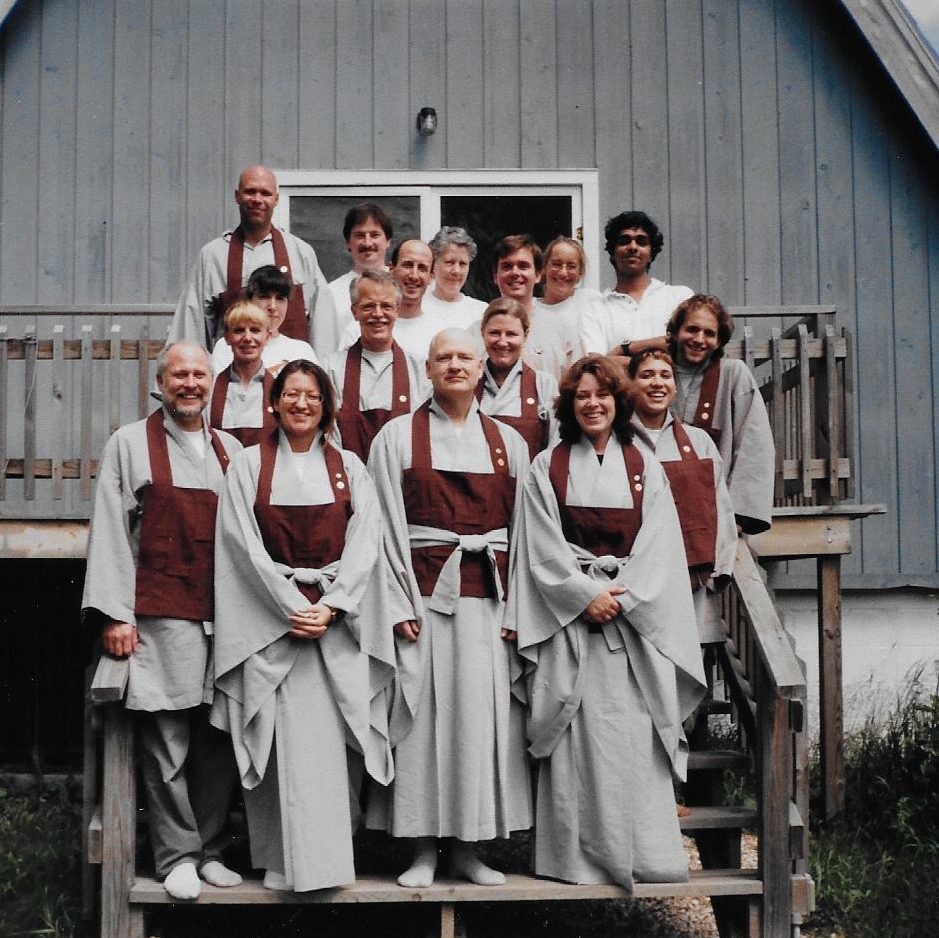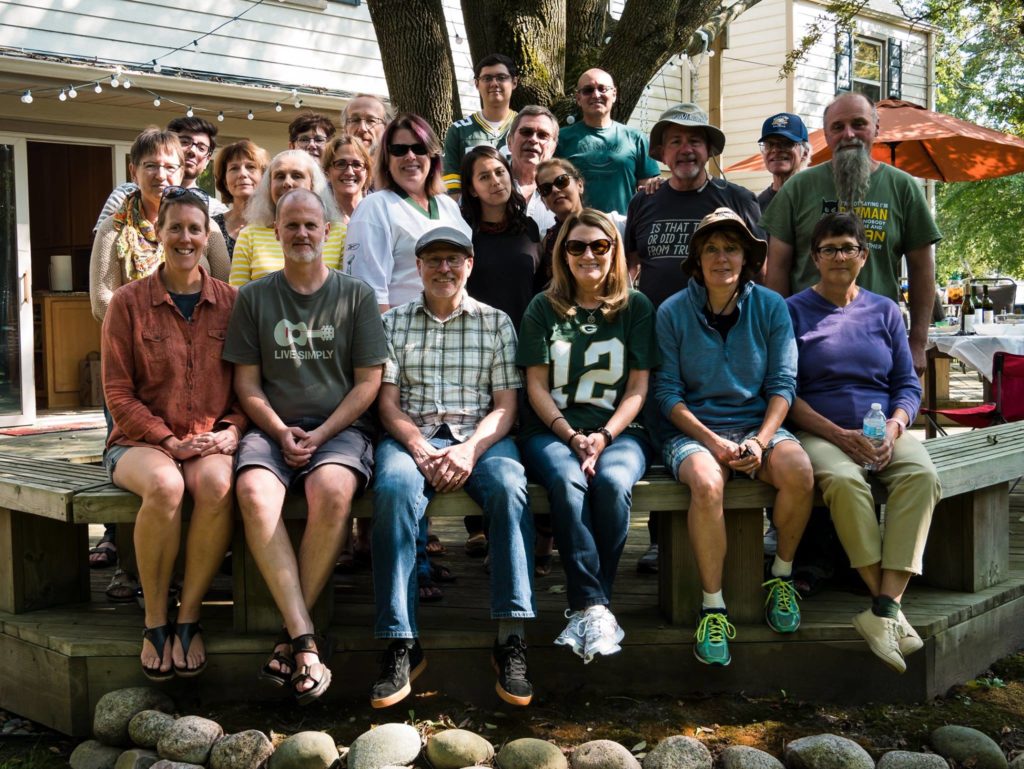Pete Neuwald
Where did our Sangha go?
Pre-pandemic, it was easy to see what our Sangha was. It was the community of dharma friends who supported each other in our Zen practice. It was all of us coming together, physically. We would meet at our Zen center for practice sessions, retreats, and workshops. We would have social gatherings as well.
For the past year, we have been meeting “virtually.” We “see” each other on our two-dimensional screens. So, are we still a Sangha? For me, the same could be asked of my family. I’ve been unable to see my kids and granddaughter for well over a year, other than virtually. The same is true with my ninety-five-year-old Mom. Are we still a family? The answer for me is, yes, we still are a family. So too, we are still a Sangha. It takes some work to keep in touch, but this has always been the case.
The dynamics of how we function have changed drastically, but the job we had as dharma friends has remained the same – to help one another in our practice. While I greatly look forward to seeing you all in person again, meeting virtually has provided some opportunities for practice that didn’t exist when we met only in person. Remote Sangha members have been able to participate in practice sessions and retreats. Also, it has been easier for people to attend sessions and events. We have had participation from people in other states and countries. Some of our members have taken advantage of the Kwan Um School of Zen’s online Sangha to participate in retreats, study groups, and practice sessions as a part of the larger Sangha.
As I mentioned, I am really looking forward to seeing most of you in person sometime this year! That said, I want to continue to “see” those of you who are unable to be present in person!

Photo courtesy of Susi Childress
Chris Rundblad
My Sangha is Small
My sangha is small.
It is a tiny planet around a middling sun
in one of a gazillion galaxies
light years apart in time and space.
My sangha is small.
It is a country wounded by disillusion and illusion
where thousands of pandemic deaths
are counted one by one by one.
My sangha is small.
It is a city on a lake where the sun rises
gold each morning to paint every single street,
building, and person the color of a new day.
My sangha is small.
It is a video collage of faces
greeting each other on a zoom screen
chanting together apart.
My sangha is small.
It is the little green worm hanging by a thread of silk
from a branch where I watch him for twenty minutes
twisting and curling down to the earth.
My sangha is small.
It is this pen and paper where I write these words to you.

Photo courtesy of Susi Childress
Suzanne Stone
It Would Have Made a Great Zen Hall!
Last weekend I assisted on a photoshoot, the purpose of which was memorialize an architectural gem slated to be torn down to make way for a new medical clinic. The location is approximately where Mitchell Street meets Forest Home Avenue. The name of the building pronounces the location, more or less: Forest Home Library. Various attempts were made to save it from being razed; however, efforts lacked resources and time and power (all the usual suspects) – the developer won.
Andi, the photographer I assisted, was hired to make large format image negatives of the interior and exterior. Think Ansel Adams and his 4×5 view camera and you’ll get an idea that this was not a simple point-and-shoot job. Each setup took 2-3 hours to frame, focus, measure, calculate, meter, and wait for best light. The process is very much like watching grass grow, and few photographers raised on the instant feedback of digital photography have the patience for it.
The day before the job, I found myself anxious with the prospect of having to wake up at 4 am so that I could be on site by 7. The first day was likely to be a 10-12 hour day, the second at least 10 hours, and the final maybe a half day (it turned out to be 8 hours). In other words, a weekend retreat without the 3 meal breaks. I was seriously asking myself why I accepted!
When I arrived and we were let in by the developer who now owned the property, the reality of what I signed onto sunk in: we were witness to the final days of what was once a thriving community library. This was not just any library; it was an expansive space where natural light entered through every window and transom, from every direction: north, south, east, and west. It was a place where a patron could come close to being inside and outside at the same time. Even in its compromised state with garbage strewn into heaps in corners as it was in the process of being gutted, and with its dirty, grimy windows from years of neglect, the light pressed through with warmth and brilliance.
During the course of the weekend, I learned through back and forth banter with the architect who was part of the historical preservation organization charged with documenting the site that he was a member of the Milwaukee Zen Center when he made the random comment that it would have made a great Zen hall. I agreed, adding that I practiced with the Great Lake Zen Center and was thinking the same thing. Then we both acknowledged how odd and unlikely it was that we crossed paths, given that the Zen Buddhism community is relatively small in Milwaukee. Yet, it was at that moment that I felt a strong connection to something bigger than I – I felt part of a community – a sangha – in support of the bigger community to which I belong.
I’m still processing the entire experience: my attachment to a pandemic routine that has shrunk my world and mind to the inside of my ranch home; my observations of Andi’s painstaking deliberations for each setup and how I might apply myself with the same measured diligence when photographing birds, landscapes, and flowers; the neighborhood rhythms – a parking lot bullhorn church sermon in Spanish blasting to the far reaches of the neighborhood punctuated with many well-placed “Alleluias,” domestic back porch disputes, crying children, drag-racing on less-than-street-legal bikes and cars, and the occasional pedestrians stopping to ask what we were up to. I wanted to say we were there to document the imminent death of your family member, but deferred to answering an honest question with as straightforward an answer as I could muster. As I now reflect, I’m mostly trying to understand how I became so attached to a building in the space of three days that up until up then I had never realized existed. I am mourning what cannot be saved and repurposed for the community it once served. (There must be some reciprocity between attachment and mourning. Actually, they may well be the same thing.) Before leaving, I dug up some crocuses, daffodils, and tulips lest they end up in a dump truck to be used for fill for some other new development, and relocated them near a hummingbird feeder in my backyard.
Alleluia!

Photo courtesy of Susi Childress
Gretchen Neuwald
Sangha-ria
Sangria, one of the most popular drinks in Iberian cuisine, is a beverage that traditionally consists of wine and chopped fruit and is often fortified with other sweeteners and spirits. There is no one recipe for Sangria. Any kind of wine, spirits, tea, soft drinks and just about any variety of fruit can be used. The wine (or other liquid) and fruit sit and muddle together for many hours. I love it because it is delicious, versatile and just about impossible to mess it up. All the disparate ingredients come together to make one fantastic, sustaining concoction. Isn’t this a nice metaphor for sangha?
Here is a Sangria that I like that uses Hibiscus tea and replaces the wine with fruit juice:
Hibiscus Sangha-ria
2 cups Hibiscus tea, brewed and chilled
1 cup orange juice
1 cup lime juice
Orange slices
Lemon slices
Lime slices
Mango slices
Black berries
Lemon Raspberry or other sparkling water for topping
Mix together the brewed tea and juices. Add the sliced fruit and chill in the refrigerated for 4-6 hours. To serve pour liquid into wine glasses and top off with sparkling water or club soda. For more sweetness, try topping with a lemon/ lime soft drink. Garnish with sliced orange and lime slices.
I omitted any alcohol to keep the recipe more precept-friendly, but red or white wine can be used instead of the fruit juices and any variety of spirits can be added. A robust red wine like Roja is often used. Other herbal teas, like green tea or Red Zinger can be substituted. Literally any variety and amount of fruit works. Have fun experimenting and creating your own brew!
Here’s to the wonderful inclusiveness and diversity of both Sangria and sangha!

Photo by Pete Neuwald
Gretchen Neuwald
Come as you are
come as you are
just as you are
happy, sullen
calm, agitated
curious, bored
mended, broken
all you are
is expected
is accepted
is welcome
is needed
come to sit with
to be with
to become friends with
just as you are
just as we are
then use this
just as you are
just as we are
to help oneself
to help each other
to help this world



